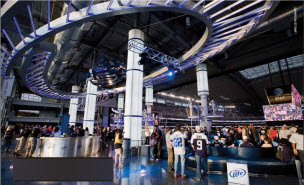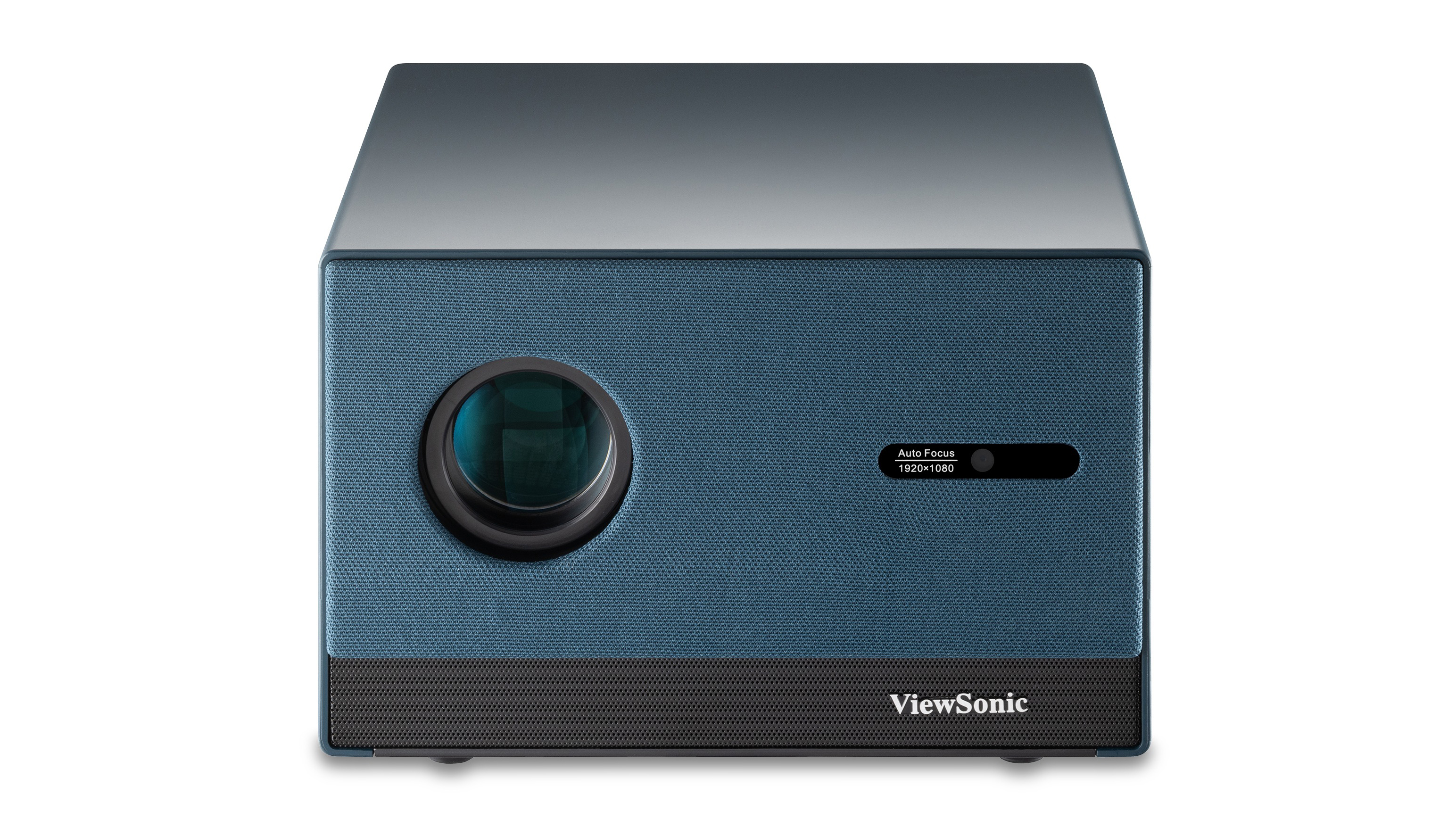Know The Score

AV Is A Major Player In Large Stadium Projects
The national economy’s apparent gradual recovery from a long and deep recession is obviously a welcome development. But for AV integrators, consultants, and manufacturers, things haven’t been all bad: while hardly recession-proof, the recent wave of stadium projects has kept the industry busy. With economic data improving, systems professionals are eyeing the future with cautious optimism.

At the new Cowboys Stadium, Clearwing Productions conducted the design and installation of two 40- x 33-foot Barco LED walls and control playback system, along with automated lighting, conventional dimming, and rigging of custom-fabricated scenic elements for the stadium’s Miller Lite Landing and event-level clubs. Media server and control consisted of Barco High End Systems Axon Media Servers.
To be sure, economic conditions have delayed or downsized some projects. The conception-to-completion span of a stadium, however, means a lag between an economic “event” and its impact on a project. “Just as there was a lag for it to start falling off, there is a lag for it to start picking up again,” observed Bradford Benn, Crown International’s director of application engineering. One consequence of the recession, he added, is that “people are looking at the networking and saying ‘How can I put this all together so that I can save my overall base building costs?’ Before, it used to be ‘I have this dollar amount for audio and this dollar amount for base building.’ Now, it’s ‘I have this much money total. How can I stretch it?’”
“People are still spending money at the stadium level, but trying to be smarter about it,” added Daniel Gourley, design and build manager for Clearwing Productions. “They may be renting more than doing a permanent fixed install. We’ve been seeing an uptick as far as doing a one-off or twotime big halftime show as opposed to ‘Let’s install a new video wall,’ or a multi-plasma kind of setup.”
Still, recent stadium projects have stayed true to state-of-the-art and “wow-factor” design. Cowboys Stadium, the new home of the Dallas Cowboys, is indicative of industry trends, said Ethan Wetzell, product manager, Electro-Voice Signal Processing, Bosch Communications Systems, which provided a large portion of the audio infrastructure.
“One of the critical aspects of that project,” said Wetzell, “was the ability to have extensive monitoring and supervision of the entire system. The sheer scope and size of the PA and the installed system as a whole makes it a real necessity for a user, a contractor, a consultant—anybody who touches the system—to have a real interactive perspective with the system.”
A daily selection of the top stories for AV integrators, resellers and consultants. Sign up below.
Bosch employed its NetMax system, with which, Wetzell explained, “an operator is able to sit at a central point and supervise, monitor, control, configure, and access any portion of the system, in real time, as they need to. They can check on the health of the electronics, the amplifiers, the signal processing. Even the loudspeaker and the cable lines can all be monitored and supervised over the network to come back.
“The AV industry is beginning to transition to a model where they’re offering services in addition to products or designs,” Wetzell continued. “This really gives them a great toolset to offer ongoing maintenance, ongoing supervision, and really expand that service portfolio that they have to be able to offer to their end-users and customers.”
Clearwing Productions also made a sizable contribution to the Cowboys Stadium experience. The Milwaukeeand Phoenix-based company was contracted by GMR Marketing on behalf of Miller Coors to develop the design and installation of two 40- x 33-foot Barco LED walls and control playback system, along with automated lighting, conventional dimming, and rigging of custom-fabricated scenic elements for the stadium’s Miller Lite Landing and event-level clubs.
Content is served from the broadcast control center, more than 2,000 feet away, by Barco High End Systems’ Axon Media Servers, controlled via a Whole Hog III console. “For the tactile, instantaneous control of a football game, and also triggering all these elements together, it was the best solution for the job,” Gourley explained. “Logistically we had to figure out how to put a feed of video chain through the in-house fiber, and also hang these walls and get that working. The complicated part was, they brought in another manufacturer that was building a 100- x 50-foot sign. By the time we all got done, it weighed about 26,000 pounds.”
Clearwing employed Color Kinetics iColor Accent Powercore LED fixtures. “We were contracted to take the sign that somebody else was manufacturing, run all of our wiring through it, and array these LEDs throughout the sign,” said Gourley. “Those LEDs are driven by either a lighting console or video itself. So you have a very flexible display surface that you can put anywhere. We ended up with about 48,000 LEDs.
“The fun part of that is, we were now controlling this entire sign from the control room. You have one place, basically, generating video content. The same position is also generating lighting content to this big sign.”
With subsidiary companies TSI Group and TSI Engineered Systems working hand in hand, TSI-Global offers an example of one-stop service: it has landed a number of stadium projects including Busch Stadium in its St. Louis, MO hometown, Citi Field in Queens, NY, Target Field in Minneapolis, MN, and the new Consol Energy Center, opening this fall as the new home of the Pittsburgh Penguins. TSI also recently completed a renovation upgrade to the St. Louis Rams’ Russell Training Center (formerly Rams Park).

The digital audio distribution infrastructure at the new Target Field stadium in Minneapolis, MN uses BSS Audio Soundweb London products networked with Crown and JBL equipment, all controlled via Harman HiQnet. Alpha Video’s Sports & Entertainment Group designed and integrated the replay control room that drives one of the largest high-definition video boards in the Midwest.
“We started the AV division about nine years ago,” said VP Paul Murdick. “We started out doing typical small AV integration with corporate and some higher education, some industrial paging, and grew from there with the contract of Busch Stadium, [for which] we supplied the voice and data cabling, the installation of the audio and SMATV system, and the broadcast system. In the past four years we have grown quite a bit—from 15 in the office to about 50.”
Manufacturers in the AV industry, Murdick observed, “are building ways and means to transport the AV on fiber, instead of giving it from a fiber distributor. The AV manufacturer is really jumping on board as far as supplying means to do so.”
“Some people decide to go digital all the way to the amp,” Benn explained, “and some have gone digital in processing. [Target Field] is very much stateof- the-art in terms of digital audio and using the [BSS Audio] Soundweb products as well as the Crown products together on one control system. There are other approaches that are a little more expensive, such as at Meadowlands, where it’s CobraNet directly to the amplifier.”
While CobraNet remains the most prominent audio distribution solution in stadiums, many IT professionals are confident in Audio Video Bridging (AVB) architecture, Benn maintained, “because it’s an IEEE standard. It’s based on 802.1, the ethernet standard, and is just an advancement of it. We’ve been working on it for a few years, drawing all the experience we’ve had with projects such as Target, Meadowlands, Lucas Oil Stadium [Indianapolis, IN], as well as theme park projects and even smaller projects like restaurants and retail spaces. It’s not a brand-new start; it’s the next evolution.”
State-of-the-art audio and video infrastructure is even seen at the college level. “It’s definitely starting to trickle down to some of the larger colleges,” Benn observed. “There are a few stadiums out there that have CobraNet and connectivity and control on the entire system, based on the same idea: it makes life easier to have a control system and have it all networked together. The thing that’s really been driving a lot of it is, by networking it together they’re able to lower the cost of ownership, whereas it used to be ‘I need eight people to look at all this stuff.’ Now, the network can look at the system for them and proactively tell them what’s going on.”
Though “convergence” has been uttered ad nauseam in recent years, it becomes more of a reality every day, these professionals say. “The way of just being a standard AV contractor is going away,” said Gourley, “where you’re dealing just with video switching systems or remote speaker systems, and having just one chain of interaction whether it’s serial control or contact closure. We’re getting to a very IT-centric, all-worlds-mixingtogether, one-panel approach, and multiple protocols talking.”
One advantage that results from this transition towards networkbased and IT-centric infrastructure, Wetzell added, is that “it goes a long way in allowing people to do retrofits and gradual upgrades over time, because so much of the core of those projects is infrastructure. When you get everything that’s able to exist on a common backbone on that infrastructure, both for control as well as audio distribution—certainly as well as video distribution—it gives a lot of leverage and possibility to be able to expand more gradually. As they bring in new, modern components, they can continue to tie them in to a common infrastructure. So they’re expanding control, functionality, and capabilities, but at the same time increasing the ease of use, the quality of both the service and the product they can offer, and keeping the cost of the project down, because they’re saving some of that infrastructure cost.”
Margin builder
One advantage that results from the transition towards network-based and IT-centric infrastructure is that it allows people to do retrofits and gradual upgrades over time, because so much of the core of those projects is infrastructure. “As they bring in new, modern components, they can continue to tie them in to a common infrastructure,” said Ethan Wetzell of Bosch Communications Systems. “So they’re expanding control, functionality, and capabilities, but at the same time increasing the ease of use, the quality of both the service and the product they can offer, and keeping the cost of the project down, because they’re saving some of that infrastructure cost.”
Christopher Walsh (chrisink@live.com) is a New York-based journalist, musician, and recording engineer.
